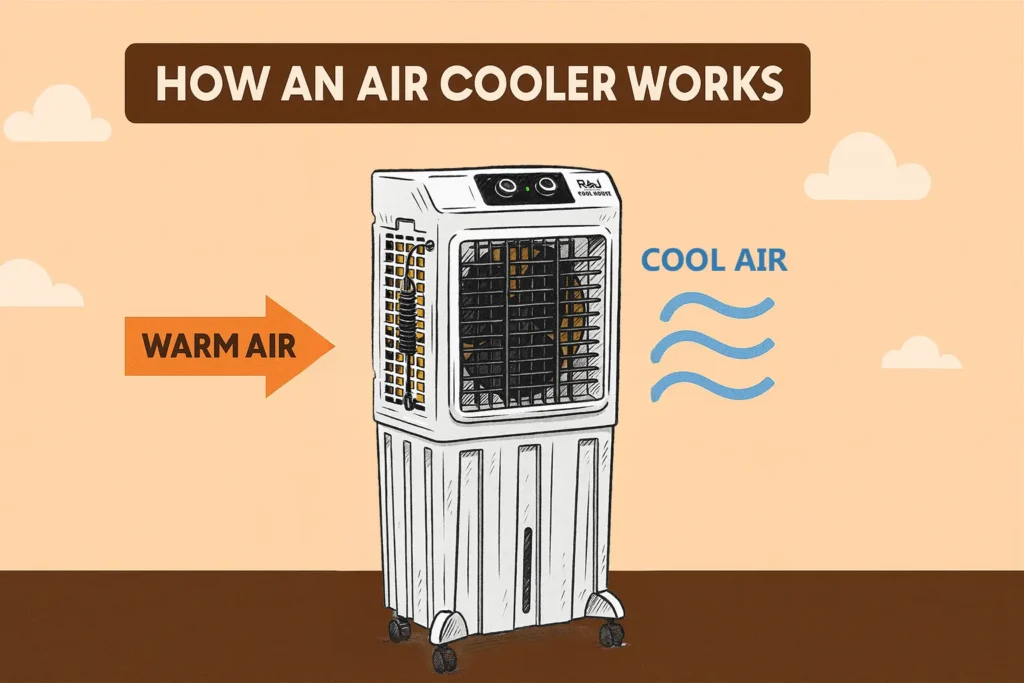Staying cool during the burning summer months doesn’t always have to mean spending a lot of money on electricity or harming the environment. Air coolers have become increasingly popular because they are cost-effective, eco-friendly, and provide natural cooling that feels refreshing and healthy. Unlike air conditioners that often recycle the same indoor air, air coolers continuously bring in fresh air, making the environment more comfortable and breathable. If you’ve ever wondered how an air cooler works, this complete beginner’s guide will explain everything step by step, from the science behind air coolers to their benefits and why they might be the perfect cooling solution for you.
What Is an Air Cooler?
An air cooler is a home cooling device that uses the natural process of water evaporation to cool the surrounding air. It is often called an evaporative cooler because it relies on this evaporation process to reduce temperatures. The main difference between an air cooler and an air conditioner is how they work and their environmental impact. Air conditioners use refrigerants and compressors to chill the air, which requires a lot of electricity and releases greenhouse gases into the environment. In contrast, air coolers are much more energy-efficient and environmentally friendly. They cool the air naturally by drawing in hot, dry air from outside, passing it through wet cooling pads, and then circulating the refreshed cool air inside the room. This makes air coolers perfect for anyone looking for sustainable and affordable cooling.
The Science Behind Air Coolers
The working principle of an air cooler is based on evaporative cooling, a natural phenomenon you’ve probably experienced yourself. Imagine stepping out of a swimming pool on a hot day. As the water on your skin evaporates, it absorbs heat from your body, leaving you feeling cool. Air coolers work on the same principle. When warm, dry air passes through water-soaked cooling pads, the water evaporates and absorbs the heat from the air, instantly lowering its temperature. The result is a flow of cool, fresh air that feels natural and soothing.
To make this process work, air coolers rely on several key components. The water tank holds the water needed for cooling, and its size determines how long the cooler can run before needing a refill. The cooling pads, often made of honeycomb or aspen material, are designed to hold water and allow maximum evaporation. A pump continuously circulates water from the tank to the pads, keeping them wet. Finally, a fan or blower draws warm air through the pads and pushes the cooled air out into the room. These components work together seamlessly to provide a consistent cooling experience.
Step-by-Step: How Air Coolers Work
The process of how an air cooler works is simple yet highly effective. It begins when the cooler pulls in warm, dry air from its surroundings. This hot air is then passed through the water-soaked cooling pads, which act like a filter. As the air comes into contact with the wet pads, the water evaporates and absorbs the heat, reducing the air’s temperature. The built-in fan or blower then pushes this freshly cooled air into the room, creating a comfortable and refreshing environment. This process repeats continuously as long as there is water in the tank and adequate airflow. The constant exchange of hot and cool air ensures that the room stays cool while maintaining a steady supply of fresh air. Unlike air conditioners, which recycle the same indoor air, this cycle makes air coolers ideal for people who value clean, breathable air.
Types of Air Coolers
Air coolers come in different designs and sizes to suit various spaces and needs. Room coolers are compact and perfect for cooling small rooms or bedrooms. Desert coolers, on the other hand, are larger and more powerful, making them ideal for cooling big spaces such as living rooms, halls, or even outdoor events. Personal coolers are small, lightweight, and portable, designed for individual use or very small areas like offices or study rooms. Tower coolers combine style with functionality, featuring a slim vertical design that fits well into narrow spaces while providing vertical airflow. Choosing the right type of air cooler depends on your space, climate, and personal requirements.
Advantages of Air Coolers
Air coolers offer numerous advantages, making them a practical choice for many households and businesses. One of the biggest benefits is energy savings, as they consume up to 80% less electricity than traditional air conditioners. This not only reduces power bills but also lowers environmental impact. Air coolers are also eco-friendly, as they operate on natural cooling without the use of harmful refrigerants or greenhouse gases. Another major advantage is that they provide a constant flow of fresh air, unlike air conditioners, which recycle stale indoor air.
Maintenance is simple and affordable. Most air coolers only require regular cleaning of the water tank and occasional replacement of cooling pads, making them low-maintenance appliances. Finally, they are cost-effective both in terms of purchase price and daily running costs, making them accessible to a wide range of users. These features make air coolers a sustainable, budget-friendly alternative to expensive cooling systems.
When Air Coolers Work Best
Air coolers work best in hot and dry climates, where humidity levels are low. In regions with dry heat, such as many parts of India, the Middle East, or the southwestern United States, the evaporation process is highly effective, resulting in excellent cooling performance. However, in areas with very high humidity, the effectiveness of an air cooler can decrease because evaporation slows down in moist air. Even in such conditions, keeping a window slightly open for proper ventilation can significantly improve the cooler’s efficiency. Understanding your local climate will help you decide whether an air cooler is the right choice for your home or workplace.
Conclusion
Understanding how an air cooler works can help you make a well-informed decision about your cooling needs. Air coolers use a simple yet powerful natural process to provide cost-effective, eco-friendly, and refreshing cooling. They are ideal for anyone looking to stay comfortable during summer without worrying about high energy bills or environmental harm. Whether you need a personal cooler for your office desk or a desert cooler for a large living space, these appliances are perfect for beginners who want sustainable cooling with minimal hassle. By choosing the right type of cooler and using it correctly, you can enjoy fresh, cool air all summer long.

